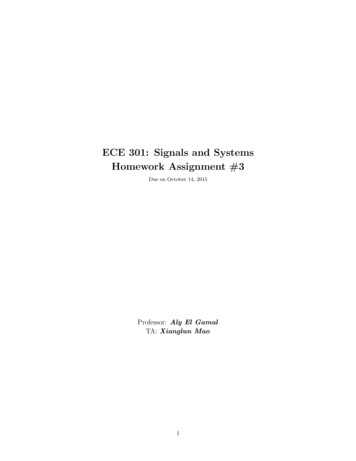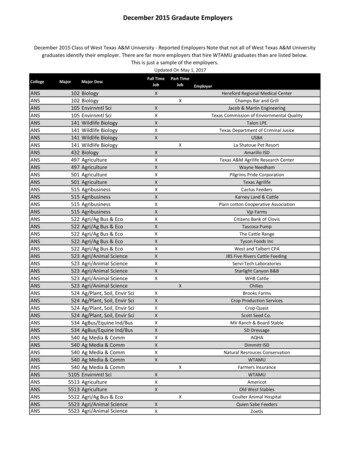
Transcription
ECE 301: Signals and SystemsHomework Assignment #3Due on October 14, 2015Professor: Aly El GamalTA: Xianglun Mao1
Aly El GamalECE 301: Signals and Systems Homework Assignment #3Problem 1Problem 1Consider a causal LTI system S whose input x[n] and output y[n] are related by the difference equation2y[n] y[n 1] y[n 3] x[n] 5x[n 4].(a) Verify that S may be considered a cascade connection of two causal LTI systems S1 and S2 with thefollowing input-output relationship:S1 : 2y1 [n] x1 [n] 5x1 [n 4],11S2 : y2 [n] y2 [n 1] y2 [n 3] x2 [n]22(b) Draw a block diagram representation of S1 .(c) Draw a block diagram representation of S2 .(d) Draw a block diagram representation of S as a cascade connection of the block diagram representationof S1 followed by the block diagram representation of S2 .(e) Draw a block diagram representation of S as a cascade connection of the block diagram representationof S2 followed by the block diagram representation of S1 .(f) Show that the four delay elements in the block diagram representation of S obtained in part (e) maybe collapsed to three. The resulting block diagram is referred to as a Direct Form II realization of S,while the block diagrams obtained in parts (d) and (e) are referred to as Direct Form I realizations of S.Solution(a) Realizing that x2 [n] y1 [n], we may eliminate these from the two given difference equations. Thiswould give us2y2 [n] y2 [n 1] y2 [n 3] x1 [n] 5x1 [n 4].This is the same as the overall difference equation.(b) The figures corresponding to the remaining parts of this problem are shown in Figure 1.Problem 1 continued on next page. . .2
Aly El GamalECE 301: Signals and Systems Homework Assignment #3 Problem 1 (continued)Figure 1: The block diagram representations in sub-questions (b), (c), (d), (e), (f).3
Aly El GamalECE 301: Signals and Systems Homework Assignment #3Problem 2Problem 2Determine the Fourier series representations for the following signals. You shall not only give the Fourierseries coefficients, but also give the Fourier series expression of the signals.(a) Each x[n] or x(t) illustrated in Figure 2.(b) x(t) periodic with period 2 andx(t) e t for 1 t 1.(c) x(t) periodic with period 4 and x(t) sin(πt), 0 t 2,0,2 t 4.Figure 2: The signal of x[n] or x(t) in sub-question (a).Solution(a)(i) It is known that N 2. So thata0 1 Xx[n]e jk(2π/N )nNN1X 1x[n]e j·0·πn2 n 0 11Xx[n]2 n 0 12Meanwhile,ak 1 Xx[n]e jk(2π/N )nNN11X x[n]e jkπn2 n 0 Problem 2 continued on next page. . .1 ( 1)k24
Aly El GamalECE 301: Signals and Systems Homework Assignment #3 Problem 2 (continued)The Fourier series representation is Xx[n] Xak ejk(2π/N )n k 1( ( 1)k )ejkπn2k (ii) It is known that T 6. So thatZ1x(t)e jk(2π/T )t dtN TZ1 6x(t)e j·0·(π/3)t dt 6 0Z1 6 x(t)dt6 0a0 0Meanwhile,1TZ1 6Zak x(t)e jk(2π/T )t dtT6x(t)e jk(π/3)t dt0Z 2Z 51 jk(π/3)tedt) (e jk(π/3)t dt)} { (61412kπkπ (cos() cos( ))jkπ33Note that not only a0 0, but also ak even 0.The Fourier series representation is Xx[n] Xak ejk(2π/T )t k (k 2kπkπ1(cos() cos( )))ejk(π/3)t (k 6 0)jkπ33(b) It is known that T 2. So thatak 1TZ12Z12x(t)e jk(2π/T )t dtT1e t e jkπt dt 1Z 1e( jkπ 1)t dt 11[e1 jπk e 1 jπk ]2(1 jkπ)for all k.The Fourier series representation isx[n] Xak ejk(2π/T )t k Problem 2 continued on next page. . . X(k 51[e1 jπk e 1 jπk ])ejkπt2(1 jkπ)
Aly El GamalECE 301: Signals and Systems Homework Assignment #3 Problem 2 (continued)(c) It is known that T 4. So that1TZ14Z1 4Za0 x(t)e jk2π/T t dtT2sin(πt)e j·0·(2π/4)t dt02sin(πt)dt0 01ak TZ1 4Z 18jx(t)e jk2π/T t dtT2sin(πt)e jk(π/2)t dt0Z2(ejπt e jπt )e jk(π/2)t dt0ejπ(2 k) 11 ejπ(2 k) 1[ ]8j jπ(1 k/2) jπ(1 k/2)e jπk( 1)k 2π(k 4)π(k 2 4) The Fourier series representation isx[n] Xk Xak ejk(2π/T )t k 6(( 1)k)ejk(π/2)t (k 6 0)π(k 2 4)
Aly El GamalECE 301: Signals and Systems Homework Assignment #3Problem 3Problem 3Consider the following three continuous-time signals with a fundamental period of T 1/2:x(t) cos(4πt),y(t) sin(4πt),z(t) x(t)y(t).(a) Determine the Fourier series coefficients of x(t).(b) Determine the Fourier series coefficients of y(t).(c) Use the results of parts (a) and (b), along with the multiplication property of the continuous-timeFourier series, to determine the Fourier series coefficients of z(t) x(t)y(t).(d) Determine the Fourier series coefficients of z(t) through direct expansion of z(t) in trigonometric form,and compare your result with that of part(c).Note that you shall only give the nonzero Fourier series coefficients as answers.Solution(a)1 4πt 1 4πte e22So that the nonzero FS coefficients of x(t) are a1 a 1 1/2.x(t) cos(4πt) (b)y(t) sin(4πt) 1 4πt1e e 4πt2j2jSo that the nonzero FS coefficients of x(t) are b1 1/2j, b 1 1/2j.(c) Using the multiplication property, we know thatFSz(t) x(t)y(t) ck Xal bk lt Therefore,ck ak bk Xal bk l t 11δ[k 2] δ[k 2]4j4jThis implies that the nonzero Fourier series coefficients of z(t) are c2 14j ,1c 2 4j.(d) We havez(t) sin(4t)cos(4t) 111sin(8t) e8πt e 8πt24j4jTherefore, the nonzero Fourier series coefficients of z(t) are c2 (c).714j ,1c 2 4j, the same with part
Aly El GamalECE 301: Signals and Systems Homework Assignment #3Problem 4Problem 4Let x(t) be a periodic signal whose Fourier series coefficients are ak 2,k 0j( 12 ) k , otherwiseKnown that the period of signal x(t) is T , use the Fourier series properties to answer the following questions:(a) Is x(t) real?(b) Is x(t) even?(c) Isdx(t)dteven?Solution(a) If x(t) is real, then x(t) x (t). This implies that for x(t), ak a k . Since this is not true in thiscase, for example,11a1 j( ) 6 j( ) a 1 .22Therefore, x(t) is not real.(b) If x(t) is even, then x(t) x( t). This implies that for x(t), ak a k . Since this is true in this case,because,11ak j( ) k j( ) k a k .22Therefore, x(t) is even.(c) We havedx(t) F S2π bk jk ak ,dtTwhere T refer to the period of signal x(t). Therefore,g(t) bk 0,k 0 k(1/2) k (2π/T ), otherwiseSince bk is not even, g(t) is not even.8
Aly El GamalECE 301: Signals and Systems Homework Assignment #3Problem 5Problem 5Let x[n] 1, 0 n 70, 8 n 9be a periodic signal with fundamental period N 10 and Fourier series coefficients ak . Also, letg[n] x[n] x[n 1].(a) Draw the graph of signal g[n], and determine the fundamental period of g[n].(b) Determine the Fourier series coefficients of g[n].(c) Using the Fourier series coefficients of g[n] and the First-Difference property, determine ak for k 6 0.Solution(a) For 0 n 9, We have 1,n 0 0,1 n 7g[n] x[n] x[n 1] 1, n 8 0,n 9This period begin to show again in the following 10 points, it’s clearly to draw the conclusion that g[n]is periodic with period of 10. The graph of signal g[n] is shown in Figure 3.Figure 3: The graph of signal g[n].(b) It is known that T 10. So that the FS coefficients of g[n] is bk , which isbk 1 Xg[n]e jk(2π/N )nNN91 X g[n]e jk(π/5)n10 n 0 1(1 e j8k(π/5) )10(c) Since g[n] x[n] x[n 1], the FS coefficients ak and bk must be related asbk ak e jk(π/5) ak .Therefore,ak bk1 e jk(π/5)9 1 1 e j8k(π/5)10 1 e jk(π/5)
1 followed by the block diagram representation of S 2. (e)Draw a block diagram representation of Sas a cascade connection of the block diagram representation of S 2 followed by the block diagram representation of S 1. (f)Show that the four delay elements in the block diagram representation of Sobtained in part (e) may be collapsed to three.











